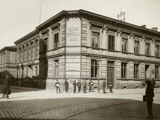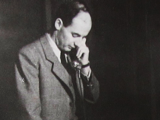ONE COLD NIGHT IN STOCKHOLM
On a winter night in February 1986, a few minutes before midnight, a couple is walking home from the Grand Cinema, on the central Stockholm street of Sveavägen. Suddenly, they are attacked by a lone gunman. They were no ordinary people: Olof Palme, Prime Minister of Sweden, was fatally killed by a single gunshot while his wife, Lisbeth Palme, was slightly wounded by a second shot. The Swedish prominent politician, and the First Lady, had no bodyguards with them on that freezing evening. The killer jogged down Tunnelgatan street, up the steps to Malmskillnadsgatan, and continued down David Bagares gata, where he was last seen. Mr Palme was declared dead soon after he was transported to the hospital. An unprecedented manhunt began. Two years later, in 1988, a drug dealer and drug addict named Christer Pettersson, a man with a serious criminal record on his shoulders, was accused of the murder after having been identified as the killer by Mrs Palme. The assassination of the Prime Minister, in a country famous for being one of the most civilized and tranquil (even too much), was a big shock across Europe. No head of state had ever been murdered in the entire Old Continent before Palme. The only assassination plot, which failed, was the one of Pope John Paul II inside Vatican City five years before. In that case, the Pontiff survived. Palme’s killing was so appalling that conspiracy theories emerged to explain an incredible homicide, which reminded a lot of the American president JFK assassination: also because Pettersson was later acquitted and still today nobody knows who killed the Swedish prime minister killer and, mostly, why. Many theories have been circulating, from an anti-apartheid endorsement Palme did one week before his assassination; to Swedish weapons trafficking and bribe with India. The late writer Stieg Larsson, who posthumously became a worldwide best-seller for the crime novel “The girl with the dragon tattoo”, for many years investigated the case: he believed Palme has been assassinated by far-right extremists in conjunction with the industrialist family of Wallenberg. It was the first time ever that the most secretive and wealthy Swedish dynasty was involved in a scandal, even if a rumour. For more than 150 years, they have been a silent and private power broker. It was not the first time, though, violent death was associated with the Wallenbergs.

THE SECRET OF BEING RICH? START A BANK
In the mid-19th century, a 30-year-old Swedish young man, called Andrè Oscar Wallenberg, travels to the US. He is the son of a bishop from Linkoping, an old medieval town south of Stockholm. He has two brothers and for each of them their father gave a name with a meaning from ancient Greek: the oldest Marcus Hilarion (the happy one), the middle one Jacob Agathon (the good) and the youngest André (from Andreios, the powerful) Oscar. But most of all, the bishop's prediction seems to have been true about André Oscar, for he became the most prominent of the brothers. Andrè has a strong faith, but it’s in finance not in Christianity: he wants to be a banker. The trip proves to be very inspirational indeed. In 1837, when in the US, he witnessed the so-called Panic of 37, a terrible financial crisis: it was when he "learned how banks should not be run". In 1856, some 20 years later, at the age of 50, he founded Enskilda Bank. The bank quickly became one of the most powerful financial institutions in Sweden and played a crucial role in the development of the country's economy in the late 19th and early 20th centuries: Wallenberg arranged bond loans of over 80 million SEK (billions of today euros) to the Government, municipalities, industry and railways. He also became a pioneer in modern banking: just one year after opening, the bank claimed to be the first one in the world to employ a woman. Thirty years later Enskilda introduced pension schemes for employees. When Oscar died, the bank’s chairperson role passed to Knut Agathon, Oscar’s son, whose name continued the family tradition of well-wishing Greek names: banking helped the Wallenberg family build a unique position in Swedish business. Some shadows appeared as well: during World War II, the family was accused of collaborating with Nazi Germany and thus U.S. Government put the bank on a Black List. The incident was nothing compared to the tragedy that was awaiting the family decades later. In 1972, the bank merged with Skandinaviska Banken to become Skandinaviska Enskilda Banken, or SEB, which is the name the bank still trades today. The new bank had at the time almost 7000 employees, 393 branches, a well-established customer base and good relationships with many of Sweden's biggest companies. It was not an easy step.

A SUICIDE DECISION
Officially, the merger was done to make the bank more competitive in the international markets. However, the main reason was political: At the time, Sweden was run by a very left-orientated social democratic party which forced restrictions on banks and private companies. Only a certain level of profit was allowed, and when Stockholm’s Enskilda Bank tried to expand, this action was held back by the Swedish government. The merger was, therefore, just a trick to bypass the law and create room for more profits. There were some problems, too: Skandinaviska Banken was about three times bigger than Enskilda Bank. With such a controversial deal, for the first time in the dynasty’s history, the Wallenberg were divided as to whether the merger should take place: chairman Marcus Wallenberg Junior was pushing for the deal, whereas the former chairman Jacob Wallenberg, son of Knut, strongly opposed the deal. The rift between family members turned into tragedy when, in November 1971, the bank’s CEO, Marc Wallenberg, one of the top negotiators of the merger, committed suicide, leaving the Wallenberg family without a natural successor in the banking business. The bank survived this family crisis, became one of the largest banks in Sweden and until very recently proved to still be a forward-looking business: 10 years ago, SEB sold its retail banking operations in Ukraine to Eurobank Group. As the Ukrainian War exploded in 2022, with many European companies stuck with losses for millions, exiting the country years before was the best decision ever.
Esse, non videri

A BIGGER BANG
After Marc’s suicide, the family still kept a controlling stake in SEB. Meanwhile, the Wallenberg have since then expanded their business into a wide range of industries, including telecommunications, mining, energy, and more. Some of the most well-known Nordic multinationals are associated with the family. The list includes the mobile phone manufacturer Ericsson: the family has a long history with the multinational telecommunications company headquartered in Sweden. The family's involvement with the company dates back to the early 20th century, and they currently own a significant stake in the company. Other relevant stakes are in Electrolux, the Swedish appliances giant, ABB, an engineering and robotics Swiss-Swedish corporation, and British industrial manufacturer Atlas Copco. The most significant stake, for its strategic value, is probably the one in SAAB, a Swedish aerospace and defence company the family has been involved with for several decades: the corporation is best known for producing fighter jets and military aircraft, including the new Tempest project, the sixth-generation air striker. Such a vast company portfolio has made the Wallenberg one of the richest families in Europe, thus gaining them “The Swedish Rothschild" nickname. In addition to their financial success, the family is also known for its philanthropic stance: they started various no-profit foundations which have donated millions of dollars to support education, health, and arts. This also includes a Wallenberg Theatre in Stockholm. Lately, their generosity extended to environmental sustainability, the new global trend. “Giving back” is a mantra for the Nordic family, but not everything goes to the public, though. They are also credited with a vast private collection of artworks, including masterpieces by the likes of Claude Monet and Edgar Degas.
He could have rested on the extraordinary laurels of his family, but he chose to build and create. He is a man of enormous competence and dimension.
HOW TO BE A GOOD INVESTOR
1982 was a pivotal year for the family. Peter Wallenberg Senior, grandson of Marcus Wallenberg Junior, SEB’s chairman, took over the family’s holding company, Investor AB, Wallenberg’s casket which was created in 1916. The change in leadership was not appreciated at the time: many said it would have marked the swan song in the family's more than 100-year dominance of the Swedish banking and industrial sectors. Yet Peter rose to the challenge, guiding the family and Sweden's industry into a new era. As a matter of fact, he focused his interests on the family's investment company. Investor AB became the family's new flagship business, and under his leadership began to actively restructure most of the industrial companies in their portfolio. Probably, the most successful decision was the creation of Stora Enso, the biggest paper and packaging company in Europe. Today, Investor AB, listed on the London Stock Exchange, has 70 billion euro in assets and some 20 billion euro in profit.
FAMILY AFFAIRS
How do you keep a family-focused for generations? First, you keep them well-educated. Several members of the Wallenberg family have attended prestigious universities such as Harvard, Stanford, and Oxford. Second, you keep family affairs very secret. Stockholm’s archipelago is 60 km wide and counts some 24,000 islands, ten times the number of Greek islands. The family has been known to hold secretive meetings at a private estate on the island of Varmdo which is not so secluded, being the largest island of the archipelago, where also the tennis star Björn Borg built his villa, but it is also so large everybody can easily hide. The “Nazi Affair” was probably also the reason for another family tragedy, involving Wallenberg’s most famous member: Raoul Wallenberg started a diplomatic career credited with saving the lives of thousands of Hungarian Jews during World War II. Wallenberg's heroic actions earned him international recognition and praise, but he disappeared in 1945 and is believed to have been killed by the Soviet Union. Russians were the fiercest German enemies, so they may have wanted to “punish” a family linked to the Nazi. At the same time, his effort to save Jews from Holocaust could be read as a way to mitigate the family’s blame. In 2015, it was revealed that another family member, Jacob Wallenberg, had been a target of espionage by Russia's FSB, the former KGB.

ITALIAN LAMBS WITH SWEDISH FLAVOUR
When you have money, Europe is a small playground. It becomes easy to shop in Milan, dance in Paris, study in London and relax in Stockholm. In the small game of social ties of high society, friendly relations can turn into an alliance of circumstances, help and dismissal. In the 1970s, the socialite world would often see Marcus Wallenberg, who was then the CEO of Investor AB, sharing events and parties with friend Gianni Agnelli, the patriarch of the Agnelli family, owner of Fiat carmaker. The two shared a love for sailing and often competed against each other in regattas around the Mediterranean. And during the same years, both Saab and Fiat had problems: the Swedish brand no longer had popular small vehicles in its catalogue whereas Fiat suffered from the opposite: very appealing small cars portfolio but missing a big car. In 1978, the two families found a solution: Saab would sell in Sweden the Italian A112, a famous mini car from Autobianchi, a subsidiary of Fiat. In reverse, Agnelli got a collaboration with Saab culminating in the Type 4 project, which would give birth to 3 iconic Italian sedan cars that would have marked the 80s: Lancia Thema, Fiat Croma and Alfa Romeo 164. The commercial agreement did not prevent SAAB from being sold to American GM in the late 80s and, similarly, Fiat to avoid financial crisis in the 90s.
Nevertheless, the Swedish and Italian families kept doing affairs together. In 1989, the Wallenberg acquired a 25% stake in the Italian insurance company, La Fondiaria, which was controlled by the Agnelli family and a crucial financial asset in Italy’s web of power: the small insurance company at the time held a strategic stake in Mediobanca, the epicentre of Italy’s finance and banking industry.
More recently, the two families have collaborated on several projects related to the automotive industry. In 2017, Investor AB, purchased a 30% stake in truck manufacturer Navistar, based in the United States. The automaker has a joint venture with CNH Industrial, another truck manufacturer owned again by the Agnelli family. It’s a small world, indeed.

By Simone Filippetti journalist of Il Sole 24 Ore

Sobre el autor
LFG Investment Consulting SA